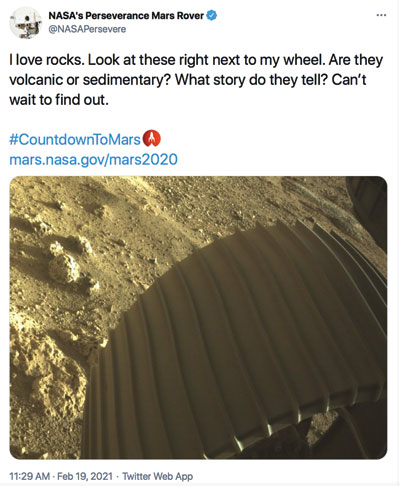 With its stark mesas and buttes, bare rock surfaces, large areas where vegetation is sparse and are devoid of man-made structures, the landscape of southern Utah can remind people, especially newcomers, of another planet. Utah landscapes have been used to depict other worlds in movies, comic strips, and TV shows. Given how Utah’s geology has been used as a stand-in for other planets in these fictional works, people may be surprised that geologists and astrogeologists actually study Utah to understand planets such as Mars. In fact, studies of our red rocks near Moab have been part of the larger scientific effort associated with the Mars rover missions, including the current Perseverance mission. While the primary objective of the Perseverance mission is to look for biosignatures in rocks that could provide information about past microscopic life, the rover itself is basically a robotic geologist on wheels who claims to love rocks like human geologists do, as indicated by one of the first tweets the rover’s handlers sent after the successful landing on Mars in February. With its stark mesas and buttes, bare rock surfaces, large areas where vegetation is sparse and are devoid of man-made structures, the landscape of southern Utah can remind people, especially newcomers, of another planet. Utah landscapes have been used to depict other worlds in movies, comic strips, and TV shows. Given how Utah’s geology has been used as a stand-in for other planets in these fictional works, people may be surprised that geologists and astrogeologists actually study Utah to understand planets such as Mars. In fact, studies of our red rocks near Moab have been part of the larger scientific effort associated with the Mars rover missions, including the current Perseverance mission. While the primary objective of the Perseverance mission is to look for biosignatures in rocks that could provide information about past microscopic life, the rover itself is basically a robotic geologist on wheels who claims to love rocks like human geologists do, as indicated by one of the first tweets the rover’s handlers sent after the successful landing on Mars in February.
Prior to the first rover missions and detailed satellite imagery collected in the late 1990s, scientists had thought that most of the rocks on Mars were volcanic in origin, like those on the moon. The Mars Global Surveyor discovered that there are several areas that had abundant hematite (iron oxide, Fe2O3), the same mineral that in very low concentrations is responsible for the planet’s red color.
The Mars rover missions have had a set of sequential goals: follow the water (Opportunity and Spirit, landed in 2004), explore habitability (Curiosity, landed in 2012), and look for signs of past life (Perseverance, arrived on Mars on February 18).
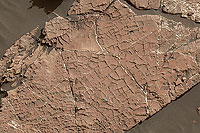 |
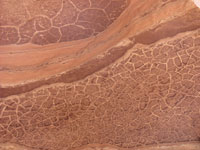 |
| Mudcracks on Mars. Curiosity rover image credit: NASA/JPL-Caltech/MSSS |
Mudcracks near the Hidden Valley Trail. These are molds that had filled in mudcracks in the layer below, which has been removed by erosion. |
Opportunity’s landing site was in a location chosen for the presence of crystalline hematite, because hematite usually forms in the presence of water. Many scientists expected that the iron would be present as rock layers, but University of Utah geologist Marjorie Chan, who has spent most of her career studying sedimentary rocks in Utah, along with some colleagues theorized prior to the mission that the hematite may instead occur as discrete nodules (concretions, which are cemented mineral masses) like the “Moki marbles” in the Navajo Sandstone in southern Utah.
Chan explained, “It was one of the most exciting moments of my career. What a thrill when we saw those first images of the Mars blueberries!”
The hematite concretions on Mars were named “blueberries” for their size, gray-blue color, and the fact that they were distributed in the rocks like berries in a muffin. The Martian blueberries are usually smaller in size than Moki marbles which can be baseball-size or larger. But they both have the same general shapes and features. It appears that both the Martian blueberries and the marbles in the Navajo Sandstone formed when large amounts of groundwater carrying iron flowed through permeable rocks. The concretions formed when chemical reactions caused iron oxide minerals to precipitate in spherical balls.
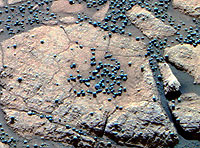 |
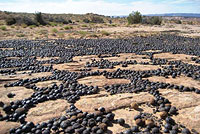 |
| Both the blueberries on Mars and the “Moki marbles” in the Navajo Sandstone are concretions made of iron oxide. |
“Moki marbles” by Margie Chan |
To prepare for the Curiosity mission, astrogeologists visited sites in Canyonlands and Arches national parks to view large scale erosion of the Colorado Plateau, observe features in the Navajo Sandstone, and see the soft sediment deformation in the Dewey Bridge Member of the Curtis Formation. Curiosity’s landing site at Gale Crater was chosen because rocks there showed evidence of deposition by water so that the mission could characterize habitable environments from the sedimentary record.
Curiosity has found that the sedimentary rocks at Gale Crater show clear evidence that they were indeed transported by water. There are coarse sandstones with shallow cross-bedding that indicate deposition in streams, conglomerates, and finer-grained sediments that likely were deposited in a lake environment. Curiosity even photographed mudcracks that formed by the drying of wet sediments. Several rock layers (formations to geologists) including the Morrison and Curtis Formations found near Moab may have been deposited in similar fluvial (river) and lake environments.
 |
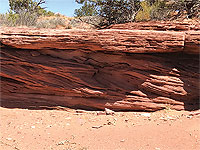 |
| Cross-bedding on Mars. Curiosity rover image credit: NASA/JPL-Caltech/MSSS |
Cross-bedding in the Kayenta Formation in Canyonlands National Park. This type of cross-bedding with low angles indicates deposition by streams. |
Perseverance’s landing site at Jezero Crater is in an ancient river delta where there are both fluvial and lake sediments. Lake beds are of special interest to astrobiologists because they are great places to look for life. Studies of dry lake beds in the Great Salt Desert in Utah were a key part of the process that NASA scientists used to choose the mission’s landing site.
One of the best ways to think of the Mars rover missions is that they are where rock science meets rocket science to explore and understand another planet. At its core, science is essentially the systematic exploration of the natural world and universe. Any explorer may end up in an unexpected destination, such as Chan’s scientific journey that led from Utah to Mars. She said, “When I first got into geology I never thought that I would be talking about another planet, but that is the serendipity of science.”
Special thanks to Marjorie Chan. Also thanks to Ryan Anderson and Elise Rumpf at the USGS Astrogeology Science Center in Flagstaff, Arizona.
|
 With its stark mesas and buttes, bare rock surfaces, large areas where vegetation is sparse and are devoid of man-made structures, the landscape of southern Utah can remind people, especially newcomers, of another planet. Utah landscapes have been used to depict other worlds in movies, comic strips, and TV shows. Given how Utah’s geology has been used as a stand-in for other planets in these fictional works, people may be surprised that geologists and astrogeologists actually study Utah to understand planets such as Mars. In fact, studies of our red rocks near Moab have been part of the larger scientific effort associated with the Mars rover missions, including the current Perseverance mission. While the primary objective of the Perseverance mission is to look for biosignatures in rocks that could provide information about past microscopic life, the rover itself is basically a robotic geologist on wheels who claims to love rocks like human geologists do, as indicated by one of the first tweets the rover’s handlers sent after the successful landing on Mars in February.
With its stark mesas and buttes, bare rock surfaces, large areas where vegetation is sparse and are devoid of man-made structures, the landscape of southern Utah can remind people, especially newcomers, of another planet. Utah landscapes have been used to depict other worlds in movies, comic strips, and TV shows. Given how Utah’s geology has been used as a stand-in for other planets in these fictional works, people may be surprised that geologists and astrogeologists actually study Utah to understand planets such as Mars. In fact, studies of our red rocks near Moab have been part of the larger scientific effort associated with the Mars rover missions, including the current Perseverance mission. While the primary objective of the Perseverance mission is to look for biosignatures in rocks that could provide information about past microscopic life, the rover itself is basically a robotic geologist on wheels who claims to love rocks like human geologists do, as indicated by one of the first tweets the rover’s handlers sent after the successful landing on Mars in February. 





